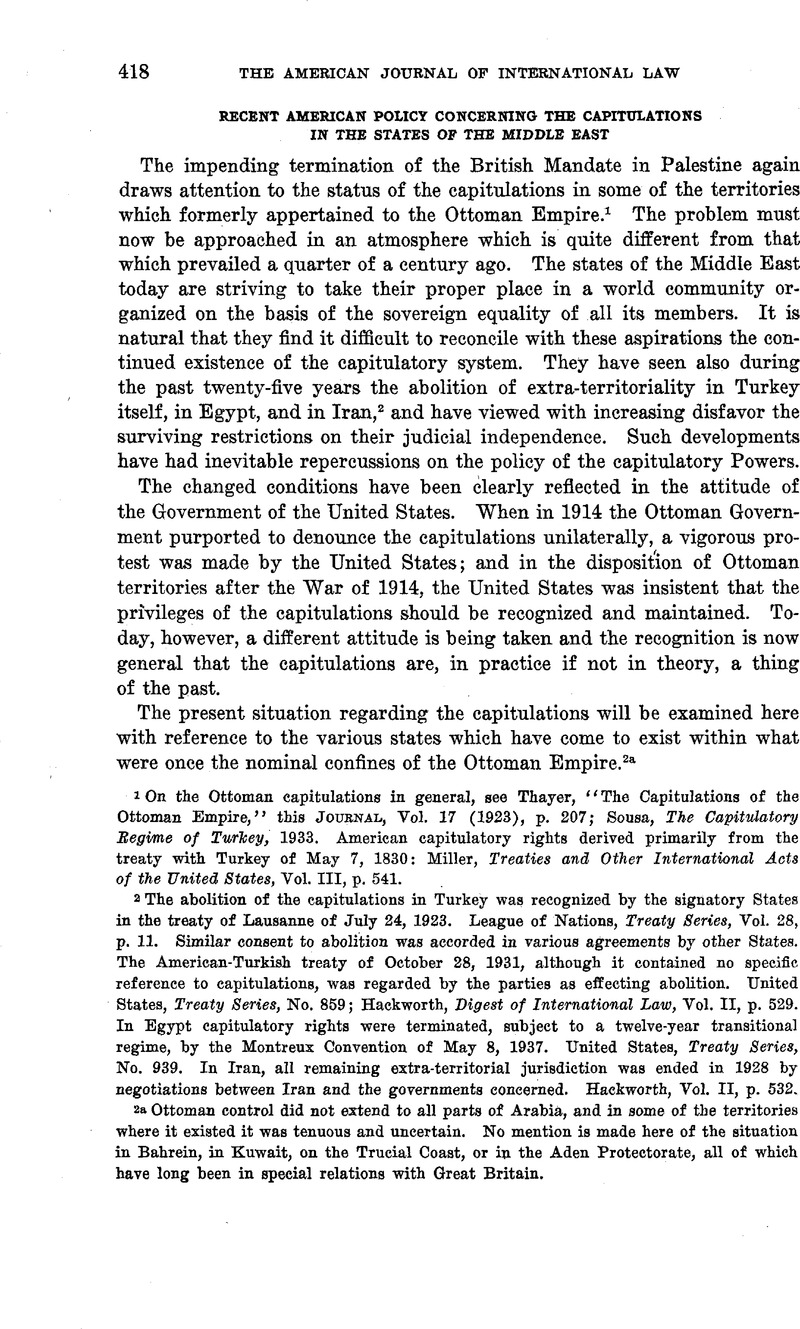No CrossRef data available.
Article contents
Recent American Policy Concerning the Capitulations in the States of the Middle East
Published online by Cambridge University Press: 20 April 2017
Abstract

- Type
- Current Notes
- Information
- Copyright
- Copyright © American Society of International Law 1948
References
1 On the Ottoman capitulations in general, see Thayer, , “The Capitulations of the Ottoman Empire,” this JOURNAL, Vol. 17 (1923), p. 207 Google Scholar; Sousa, , The Capitulatory Regime of Turkey, 1933. American capitulatory rights derived primarily from the treaty with Turkey of May 7, 1830: Miller, Treaties and, Other International Acts of the United States, Vol. III , p. 541.Google Scholar
2 The abolition of the capitulations in Turkey was recognized by the signatory States in the treaty of Lausanne of July 24, 1923. League of Nations, Treaty Series, Vol. 28, p. 11.Google Scholar Similar consent to abolition was accorded in various agreements by other States. The American-Turkish treaty of October 28, 1931, although it contained no specific reference to capitulations, was regarded by the parties as effecting abolition. United States, Treaty Series, No. 859; Hackworth, , Digest of International Law, Vol. II , p. 529.Google Scholar In Egypt capitulatory rights were terminated, subject to a twelve-year transitional regime, by the Montreux Convention of May 8, 1937. United States, Treaty Series, No. 939. In Iran, all remaining extra-territorial jurisdiction was ended in 1928 by negotiations between Iran and the governments concerned. Hackworth, Vol. II , p. 532.
2a Ottoman control did not extend to all parts of Arabia, and in some of the territories where it existed it was tenuous and uncertain. No mention is made here of the situation in Bahrein, in Kuwait, on the Trucial Coast, or in the Aden Protectorate, all of which have long been in special relations with Great Britain.
3 Hudson, , International Legislation, Vol. I, p. 109.Google Scholar
4 United States, Foreign Relations, 1921, Vol. II, pp. 106–107; 1922, Vol. II, pp. 268–302.Google Scholar
5 United States, Treaty Series, No. 728.
6 Hackworth, Digest, Vol. II, pp. 517–523.Google Scholar
7 United Nations Document A/516, November 25, 1947, p. 23.
8 British Report to the League of Nations on the Administration of Palestine and Transjordan for 1929, Colonial No. 47 (1930), p. 153.
9 Great Britain, Treaty Series, No. 32 (1946).
10 League of Nations, Official Journal, Special Supplement No. 194, p. 278.
11 Letter of Secretary of State Byrnes to Senator Myers, April 23, 1946. Department of State Bulletin, Vol. 14 (1946), p. 765.Google Scholar
12 Hudson, , International Legislation, Vol. I, p. 99 Google Scholar. For diplomatic correspondence relative to Article 5, see United States, Foreign Relations, 1921, Vol. I, pp. 922–924; 1922, Vol. II, pp. 117–134.Google Scholar
13 United States, Treaty Series, No. 695.
14 League of Nations, Official Journal, Special Supplement No. 194, p. 278.
15 Exchange of Notes with the Government of Syria, November 1–2, 1946, Great Britain, Treaty Series, No. 37 (1947); with the Lebanese Government, January 22, 1947, same, No. 45 (1947).
16 Exchange of Notes with Syria, United States, Executive Agreement Series, No. 434; with Lebanon, No. 435.
17 League of Nations, Official Journal, 1924, pp. 1346–1347.
18 United States, Treaty Series, No. 835.
19 Hackworth, , Digest, Vol. II, pp. 524–527.Google Scholar
20 League of Nations, Official Journal, 1932, pp. 1213–1216, 1850.
21 The Mandatory Power took the view that American rights were regulated by the treaty of 1930.
22 Hackworth, as cited, p. 526.
23 United States, Treaty Series, Nos. 907, 960.
24 United States, Executive Agreement Series, No. 53.
25 Saudi Arabia and Great Britain (which formerly exercised extra-territorial jurisdiction in parts of Saudi Arabia) agreed in the treaty of Jeddah of May 20, 1927, that “the principles of international law in force between independent Governments” should be respected by each party with regard to the nationals of the other. Great Britain, Treaty Series, No. 25 (1927).
26 Department of State Bulletin, Vol. 15 (1946), p. 94.Google Scholar
27 Great Britain obtained extra-territorial privileges in Yemen by a treaty of January 15, 1821. Aitchison, , Treaties, Engagements, and Sanaa's Relating to India and Neighbouring Countries, 5th ed., Vol. XI, pp. 37, 171 Google Scholar. But in its treaty with Yemen of February 11, 1934, it agreed that its nationals should be governed by local laws, subject to most favored nation treatment: Great Britain, Treaty Series, No. 34 (1934).
28 An American Consulate was established at Muscat in 1880, but was closed in 1915. Aitchison, as cited, p. 272.
29 Miller, , Treaties and Other International Acts of the United States, Vol. III , p. 789; 2 Hackworth, Digest of International Law, p. 530.Google Scholar
30 Modern translation of the original Arabic in Miller, , Treaties, etc., Vol. III , p. 801.Google Scholar
31 Treaty of February 5, 1939. Great Britain, Treaty Series, No. 29 (1939).




